More archive discoveries
Recently we have featured the following items from our archives.
A number of RCVS paintings can be seen online on BBC ‘Your paintings‘
More information on items from our archives can be found on the Historical Collections blog.
| A troubled artist: Sir Edwin Landseer |
|
Landseer (1802-1873), an English painter, was renowned for his paintings of horses and dogs. Included in his artistic achievements are the lion sculptures in Trafalgar Square. His dog paintings of the 1830′s are by far his most popular work, ‘Dignity and Impudence’ (1839) being the most famous of all. |
| Almost 200 years old - a model hoof |
|
|
| Jean-Pierre Megnin - a skilled illustrator and pioneering forensic entomologist |
|
Throughout his life Megnin wrote articles and books on a wide variety of subjects (his main interests were parasitology and skin conditions in domesticated animals) illustrating most of them himself. There are many examples of his skilled draughtsmanship in our collections. |
| Veterinary receipt books |
|
|
| Presidential chair |
|
|
| Stordy, Robert John (191?) From Nairobi to the Red Sea through Ethiopia being an account of a mission to the Abyssinian government and a visit of inspection to the northern frontier district of British East Africa (22575) |
|
|
| Presidential badge and chain |
|
|
| College mace |
|
|
| The Odiham Society’s original hand written minute book covering the period 1783 – 1796 (16494-1001) |
|
|
 The RCVS headquarters tidy-up has revealed another gem, and led us to discover the fascinating story of a troubled man. Eight large prints of paintings by Sir Edwin Henry Landseer (1802-1873), depicting animals and bucolic scenes, have been discovered.
The RCVS headquarters tidy-up has revealed another gem, and led us to discover the fascinating story of a troubled man. Eight large prints of paintings by Sir Edwin Henry Landseer (1802-1873), depicting animals and bucolic scenes, have been discovered. During the recent reordering of the RCVS headquarters a 6 inch square box was found containing a cardboard model and a folded piece of paper. Further investigation revealed it was something rather exciting – the pasteboard model of a horse's hoof which accompanies Bracy Clark’s two page pamphlet A new exposition of the horses’ hoof.
During the recent reordering of the RCVS headquarters a 6 inch square box was found containing a cardboard model and a folded piece of paper. Further investigation revealed it was something rather exciting – the pasteboard model of a horse's hoof which accompanies Bracy Clark’s two page pamphlet A new exposition of the horses’ hoof. Jean-Pierre Megnin (1828-1905) graduated from Alfort Veterinary School in 1853 and served in the French army from 1860 until his retirement in 1885. Retiring from the army he founded the journal L’Eleveur (The Breeder).
Jean-Pierre Megnin (1828-1905) graduated from Alfort Veterinary School in 1853 and served in the French army from 1860 until his retirement in 1885. Retiring from the army he founded the journal L’Eleveur (The Breeder).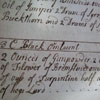 Our archives contain a number of 18th and 19th Century manuscript veterinary receipt books. Receipt books were compiled by animal owners and contained recipes for pills and receipt lists obtained from farriers when medicines were prescribed.
Our archives contain a number of 18th and 19th Century manuscript veterinary receipt books. Receipt books were compiled by animal owners and contained recipes for pills and receipt lists obtained from farriers when medicines were prescribed.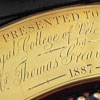 The chair is a high-backed oak chair with the RCVS coat of arms carved on the back; the arms of the chair have carved horses’ heads. A brass plaque on the chair reads: “Presented to the Royal College of Veterinary Surgeons by Mr Thomas Greaves FRCVS 1887.”
The chair is a high-backed oak chair with the RCVS coat of arms carved on the back; the arms of the chair have carved horses’ heads. A brass plaque on the chair reads: “Presented to the Royal College of Veterinary Surgeons by Mr Thomas Greaves FRCVS 1887.”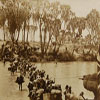 Colonel Robert John Stordy CBE DSO MRCVS graduated from Edinburgh in 1894. Four years later he took up his first appointment in British East Africa as Veterinary Officer. In 1910 he was promoted to Chief Veterinary Officer.
Colonel Robert John Stordy CBE DSO MRCVS graduated from Edinburgh in 1894. Four years later he took up his first appointment in British East Africa as Veterinary Officer. In 1910 he was promoted to Chief Veterinary Officer.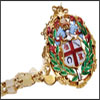 The badge and chain was presented to Council on 8April 1904 by Council member Mr John Archibald Watt Dollar. At the same meeting, members of Council presented a presidential robe.
The badge and chain was presented to Council on 8April 1904 by Council member Mr John Archibald Watt Dollar. At the same meeting, members of Council presented a presidential robe.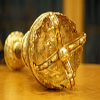 If you have attended RCVS Day or an RCVS Council meeting, you will have seen the College mace in all its glory. It is a beautiful object, and imbues important RCVS meetings with an air of dignity and ceremony. But where did it come from, and what does it depict?
If you have attended RCVS Day or an RCVS Council meeting, you will have seen the College mace in all its glory. It is a beautiful object, and imbues important RCVS meetings with an air of dignity and ceremony. But where did it come from, and what does it depict?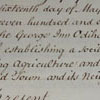 One of the most important items in the RCVS archives is the original minute book of the Odiham Society. The minute book, which was acquired by the RCVS Registrar Mr WGR Oates in 1956, allows us to trace the beginnings of the veterinary profession in Great Britain.
One of the most important items in the RCVS archives is the original minute book of the Odiham Society. The minute book, which was acquired by the RCVS Registrar Mr WGR Oates in 1956, allows us to trace the beginnings of the veterinary profession in Great Britain.